A Guide to Stand Up Paddleboarding (SUP) For Beginners
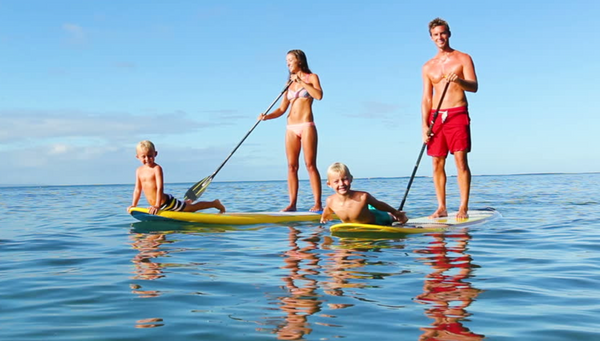
Stand up paddle boarding is a fun activity you can do on oceans, lakes, rivers, and bays. It’s a great full body core workout and way to experience the beauty of the UAE. Best of all, it’s perfect for people of all ages, body types and skill levels. There’s even enough room to paddle with a dog, friend, child or significant other. Over the years, paddle boarding has continued to grow in popularity because it gives you the freedom to explore the beautiful waters the surround our planet. We are lucky to have generally calm waters around the UAE and although mostly ocean, there are some amazing places to paddle all around the Emirates
- Types of SUPs
- Basic paddle board equipment
- How To Size Your SUP Paddle
- How to stand up on a SUP
- Paddling techniques
- Best paddle boarding tips
- How to transport your paddle board
1. Types of SUPs
Stand up paddle boards come in all shapes and sizes. The most common type of paddle board is your traditional epoxy paddle board aka hard paddle board. An epoxy paddle board is fiberglass wrapped around an EPS foam core, with one or more fins to help the board track in the water.
In 2014, a new paddle board construction was born – inflatable paddle boards. Today, inflatable paddle boards are super popular. Inflatable SUPs are great stand up paddle boards because they provide many benefits that epoxy paddle boards do not. However, both types of paddle boards are great options depending on your lifestyle and needs.
Which one is right for you?
A stand up paddle board is much thicker than your average surfboard. Paddle boards typically range from 8 to 12'6 feet in length, 24 to 34 inches wide and 4 to 6 inches thick.
Beginner paddler boarders should choose a wider, longer and thicker board. This will offer the greatest stability to learn the paddle board basics on a flat body of water. As you gain experience, you can progress to a smaller paddle board. The most common SUP shape for beginners is an All-Around paddle board. However, there are a few different types and shapes of paddle boards to consider.
All Around SUPS
- Perfect for SUP beginners, all around SUPs are the most common type of paddle board
- These SUPs can be used in all conditions from ocean waves to gliding through calm lakes
- The most versatile SUP which can be used for several SUP activities including: SUP yoga, SUP fishing, SUP touring and SUP surfing
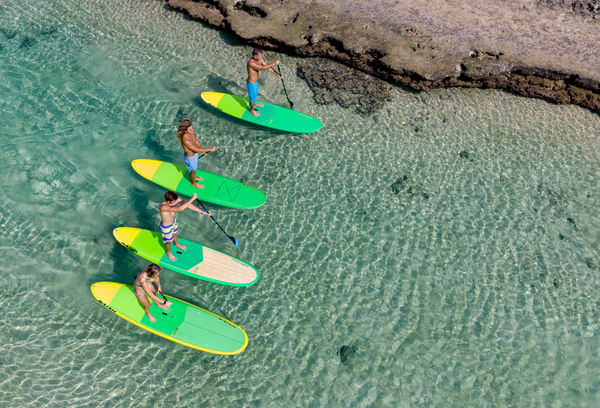
Inflatable SUPS
- Easiest paddle board to store because they roll up to the size of a sleeping bag
- Best paddle board for traveling because it can easily fit inside any car
- Super durable. If you drop it, it will not be damaged
- Great SUP for beginners
Examples:
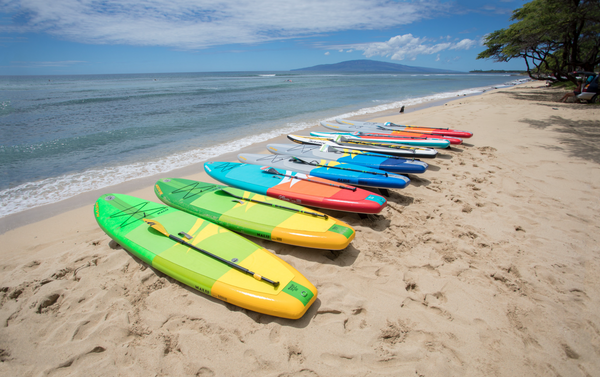
Yoga SUPs
- Has an expansive deck pad, giving you more room for your yoga flow
- Inflatable SUPs are better for SUP yoga because you sit higher up on the water keeping you dry and more stable
- Many yoga enthusiasts are beginning to practice on the water vs land
- Can also be used as a beginner recreational paddle board
Examples:
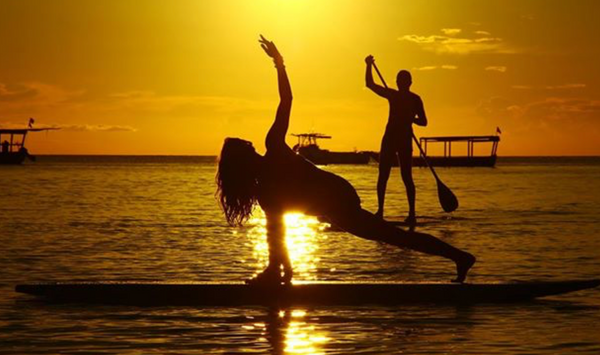
Touring SUPs
- Ideal SUP for long distance paddling adventures
- Longer, less wide SUP with a pointed nose
- Typically has a displacement hull for better tracking
Examples
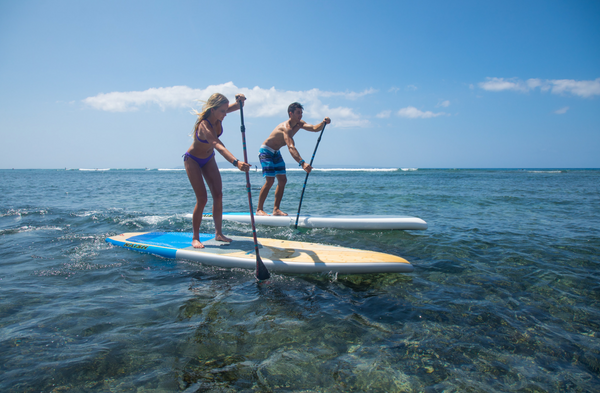
Surf SUPs
- Designed for surfing waves in the ocean
- Maneuverable and responsive in the surf
- Least stable on the water
- Challenging for beginners, but practice makes perfect

Racing SUPs
- Designed for race competitions
- Longest type of SUP which generates speed and glide efficiency
- Challenging for beginners
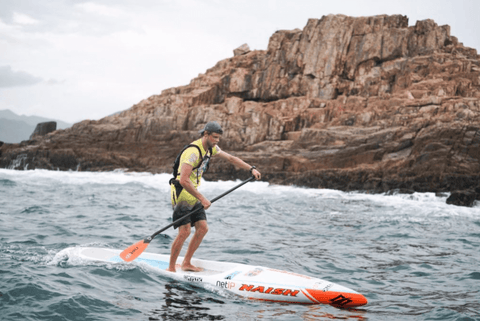
2. Basic Paddle Board Equipment
Once you’ve chosen the type of paddle board you want, you’ll also need a few pieces of paddle board equipment including a paddle, leash, board bag, and personal flotation device (PFD).
Stand Up Paddles
Stand Up Paddles come in a variety of constructions including: plastic, aluminum, wood and carbon fiber. All of these constructions come with a variety of handles, blades and shaft shapes. The general rule is that the paddle used with your paddle board should always be 6 to 10 inches above the height of the paddler. Size your paddle on the longer side for flat water use and the shorter side for use in the surf. The blade is typically bent at a slight angle to the shaft to allow for more forward reach when taking a stroke.

SUP Leash
A SUP leash keeps your paddle board attached to you with a Velcro strap around your ankle (or calf). Leashes come in a variety of sizes, and the general rule is to use a leash around the same size or slightly smaller than your board. In the event of a fall, currents and winds can quickly sweep your paddle board away from you – and in the ocean, your board becomes a lethal weapon when carried with the force of an ocean wave. Always remember to use your leash!

SUP Board Bags
The majority of dings and blemishes happen outside of the water – usually in transportation or storage. SUP board bags will remove that dilemma and conveniently aid in traveling, as well as add years to your board’s life. Note, inflatable SUPs usually come with a board bag.

Paddle Board Life Vest – PFD (personal floatation device)
Whenever you use your stand up paddle board we always recommend that you use a PFD even if you are a strong swimmer. Remember, a lot of things can happen out in the water and the PFD could save your life. It’s important to understand the Life Vest Safety Laws before you get out on the water. as it differs from country to country with some having compulsory wear rules Learn more from the WPA (World Paddle Association).

3. How To Size Your SUP Paddle
There are several correct ways to size your SUP paddle. Correctly sizing your SUP paddle will vary from person to person and the type of paddling you plan on doing. Your paddle’s length should be customized to:
- How tall you are
- Your arm length
- Your paddle board’s height above the water (epoxy, inflatable, soft top)
- The type of paddle boarding you plan on doing (recreational, touring, surfing, racing)
There are four SUP paddle sizing methods for you to try out. One method may work better than the other. Find the method that will provide you with the most comfort and paddle efficiency.

4. How To Stand Up On A Sup
Always start in calm, flat water with a nice wide board. We recommend using a 30-inch board that is about 11 feet long for all SUP beginners.
The board should feel comfortable and not unstable when standing up. If it still feels too unstable after several attempts to gain your balance, try a larger, wider paddle board.
Follow these steps to stand up on a SUP:
- Get the board out into in water so the fin is free from hitting the bottom
- Start in a kneeling position – on your knees take a few strokes on each side of the board
- Slowly, stand up with one foot at a time and stay in the middle of the board with your feet parallel to the stringer – about shoulder width apart
- Keep a slight bend in the knees and your core centered over the board
- Keep in mind you may fall off, when you do, hop back up and try again. If you get cold easily, we recommend wearing a thin wetsuit.
SUP Beginner Tip: Many people start out on a board much too small, and can never seem to gain balance and become disheartened. Learn more about how to choose the right size SUP board for you. If you’re unsure, always go wider and thicker.
5. Paddling Techniques
There are a few basic philosophies on paddle technique, but all revolve around using your paddle as a lever. Your top hand will be driving the lever and the bottom hand will act as the pivot point.
How to Paddle Forward
- Keep your bottom arm straight and relatively still.
- Pull your top arm toward your body to extend the paddle forward.
- Rotate your top shoulder forward and extend your reach.
- Insert the paddle into the water as far forward as possible and bury the paddle into the water.
- Rather than pulling you paddle through the water, think about pulling past your paddle.
- To stay in a straight line, take a few strokes on one side then switch to a few strokes on the other.
SUP Beginner Tip: Always remember to switch the position of your hands when your paddle changes sides to efficiently paddle your SUP.
How to Paddle: Turning with the Forward Sweep Stroke
- To turn left, place the paddle in the water on the right side. At the same time, turn your torso to the left side.
- Keep a low stance and pull to the right, towards the tail with the paddle, while twisting and leaning to the left with your torso. You’ll feel the board shift to the left quickly.
How to Paddle: Turning with the Reverse Sweep Stroke
- To turn right, place the paddle near the tail and pull toward the nose while shifting your torso to the right — this will spin your board’s nose to the right hand side — the more you bend your knees, the easier it will be to turn the board.
6. Best Paddle Boarding Tips
To ensure you have the best time on your SUP use our top paddle boarding tips to avoid making the common SUP mistakes.
- DO: Always hold the paddle with one hand on the top of the handle and the other on the shaft.
- DON’T: hold the paddle like a broomstick, with both hands on the shaft.
- DO: Keep your feet parallel, spread shoulder width apart, and your toes pointed toward the nose.
- DON’T: Get in a surf stance – everyone wants to, but that makes paddling on the flat water ten times harder. Plus, you will fall. Save your surf stance for the surf.
- DO: Make sure your grip on the paddle is shoulder width apart — short grips will give you a powerless stroke.
- DON’T: Only use your arms – you’ll get tired faster and not paddle efficiently. Let your big back muscles do the brunt of the work.
- DO: Dip the blade fully into the water and take a long stroke, letting your large back muscles do the work.
7. How To Transport Your Paddle Board
Since paddle boards are so large, getting your SUP to the local beach or your next travel destination can be a difficult task. Here are some tips to help make it easier.
- Shoulder Carry – With the paddle in one hand, lift the board from the tail with the nose on the ground. Walk to the center of the board and shift the board’s weight back to balance on your head. You can then shift the board over to balance on your shoulder. To lay the board back down, just follow the steps in reverse order.
- Handle Carry – The carry handle is a small handle installed at the center point of our boards so you can carry it to and from the water simply. Just lift the board by its handle and go.
- Car Racks – Paddle boards can be strapped on any vehicle with car racks. Most surfboard soft racks will fit a paddle board. Or, if your vehicle already has an existing rack system, you can simply use straps to tie down the boards to the existing hard rack. Some racks even having locking devices to protect you boards from theft. Many people just throw a towel on top of the car and run straps through the doors.
- Air Travel – For airplane travel, many companies make paddle board travel bags to carry your paddle board. These are typically padded, but it’s always recommended to add some extra padding of your own (such as towels or bubble wrap.) Also, keep in mind surfboard and paddle board charges of your airline before you book your ticket. Use this breakdown of SUP board bag charges by airline.
Visit our store and view everything SUP or contact us if you have any questions

sNDVYnmtKLzkpP
EeVlsHnG
NDcGonkCYwruXv
gRdbaHCk
bujdmwqSvp
WSiQXAcnoDgs
mOjVWBLb
ReWhnoJMS
IomdKsSG
bAzWOXNHieYhw